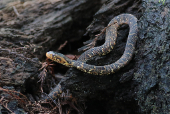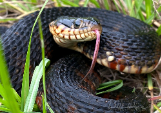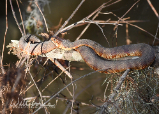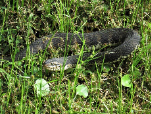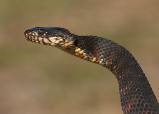Southern Banded Water Snake (Nerodia fasciata fasciata)
Description: Adult Southern Watersnakes are about 22-42 inches (56-107 cm) in total length, with a record length of 62.5 inches (158.8 cm). These are stout-bodied snakes with broad black, brown, or red crossbands (often bordered with black) down the back. The lighter narrower bands are tan, gray, or reddish and may contain a dark spot on the side. The light bands may be broken by a black strip down the middle of the back. The crossbands may be obscured as the snake darkens with age, and older individuals may become uniformly black. The background color may be gray, yellow, tan, or reddish. The belly is light with squarish spots or creamy yellow with wormlike red or black markings. The scales are strongly keeled (each scale has a prominent raised ridge), and there are 21-25 dorsal scale rows at midbody. The pupil is round. A dark stripe extends from the eye to the angle of the jaw. The tongue is red with a black tip. Juveniles have very clear crossbands (usually black) on a pale background, but otherwise their coloration is similar to that described for adults.
Habitat: Southern Watersnakes can be found in generally any areas near shallow bodies of freshwater, such as ponds, swamps, marshes, and ditches. Adults and juveniles of this species are often found in suburban neighborhoods where development encroaches into favorable habitats.
Range: Nerodia f. fasciata is indigenous to most of the U.S. Coastal Plain including North Carolina, South Carolina, Georgia, southern Mississippi, southern Alabama, and the Florida panhandle, but excluding peninsular Florida
Diet: Southern Watersnakes are typically nocturnal (active at night) and feed primarily on frogs and freshwater fishes. Southern Watersnakes are not constrictors and overpower their prey by simply grabbing it in their jaws and quickly swallowing it alive.
Reproduction: females typically give live birth to 6-83 young between July and September.
Status: Listed as Least Concern in view of its wide distribution, presumed large population, and because it is unlikely to be declining fast enough to qualify for listing in a more threatened category.
»» Kingdom: Animalia - Animals
»» Phylum: Chordata - Chordates
»» Subphylum: Vertebrata - Vertebrates
»» Class: Reptilia - Reptiles
»» Order: Squamata - Scaled Reptiles
»» Suborder: Serpentes
»» Superfamily: Colubroidea
»» Family: Colubridae - Colubrids
»» Genus: Nerodia
»» Species: Nerodia fasciata - Banded Water Snake
»» Subspecies: Nerodia fasciata fasciata - Southern Banded Water Snake
This article uses material from the Wikipedia article "Banded Water Snake", which is released under the Creative Commons Attribution-Share-Alike License 3.0. Content may have been omitted from the original, but no content has been changed or extended.
|


